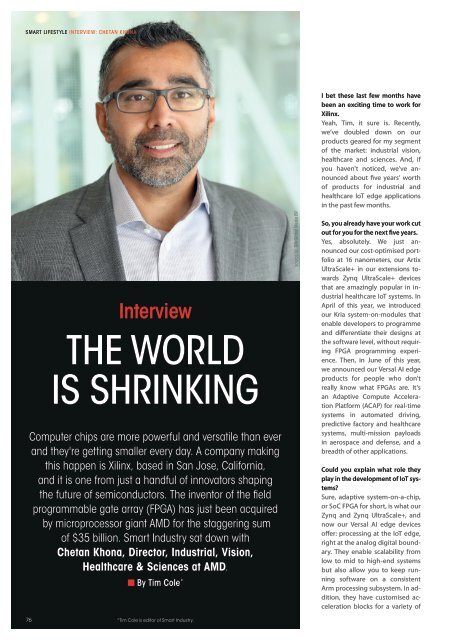Smart Industry No.1 2022
Smart Industry No.1 2022 - The IoT Business Magazine - powered by Avnet Silica
Smart Industry No.1 2022 - The IoT Business Magazine - powered by Avnet Silica
Create successful ePaper yourself
Turn your PDF publications into a flip-book with our unique Google optimized e-Paper software.
<strong>Smart</strong> Lifestyle Interview: Chetan Khona<br />
I bet these last few months have<br />
been an exciting time to work for<br />
Xilinx.<br />
Yeah, Tim, it sure is. Recently,<br />
we’ve doubled down on our<br />
products geared for my segment<br />
of the market: industrial vision,<br />
healthcare and sciences. And, if<br />
you haven't noticed, we've announced<br />
about five years’ worth<br />
of products for industrial and<br />
healthcare IoT edge applications<br />
in the past few months.<br />
Interview<br />
The World<br />
is Shrinking<br />
Computer chips are more powerful and versatile than ever<br />
and they're getting smaller every day. A company making<br />
this happen is Xilinx, based in San Jose, California,<br />
and it is one from just a handful of innovators shaping<br />
the future of semiconductors. The inventor of the field<br />
programmable gate array (FPGA) has just been acquired<br />
by microprocessor giant AMD for the staggering sum<br />
of $35 billion. <strong>Smart</strong> <strong>Industry</strong> sat down with<br />
Chetan Khona, Director, Industrial, Vision,<br />
Healthcare & Sciences at AMD.<br />
n By Tim Cole *<br />
source ©: TIM Global Media BV<br />
So, you already have your work cut<br />
out for you for the next five years.<br />
Yes, absolutely. We just announced<br />
our cost-optimised portfolio<br />
at 16 nanometers, our Artix<br />
UltraScale+ in our extensions towards<br />
Zynq UltraScale+ devices<br />
that are amazingly popular in industrial<br />
healthcare IoT systems. In<br />
April of this year, we introduced<br />
our Kria system-on-modules that<br />
enable developers to programme<br />
and differentiate their designs at<br />
the software level, without requiring<br />
FPGA programming experience.<br />
Then, in June of this year,<br />
we announced our Versal AI edge<br />
products for people who don't<br />
really know what FPGAs are. It’s<br />
an Adaptive Compute Acceleration<br />
Platform (ACAP) for real-time<br />
systems in automated driving,<br />
predictive factory and healthcare<br />
systems, multi-mission payloads<br />
in aerospace and defense, and a<br />
breadth of other applications.<br />
Could you explain what role they<br />
play in the development of IoT systems?<br />
Sure, adaptive system-on-a-chip,<br />
or SoC FPGA for short, is what our<br />
Zynq and Zynq UltraScale+, and<br />
now our Versal AI edge devices<br />
offer: processing at the IoT edge,<br />
right at the analog digital boundary.<br />
They enable scalability from<br />
low to mid to high-end systems<br />
but also allow you to keep running<br />
software on a consistent<br />
Arm processing subsystem. In addition,<br />
they have customised acceleration<br />
blocks for a variety of<br />
76<br />
*Tim Cole is editor of <strong>Smart</strong> <strong>Industry</strong>.
















